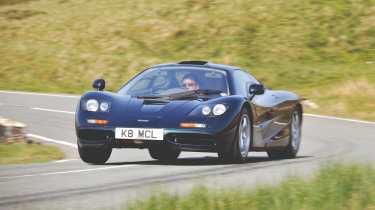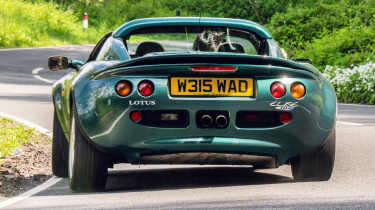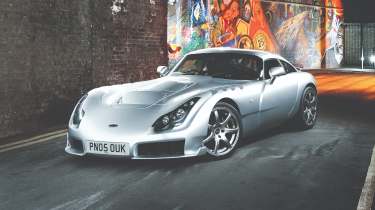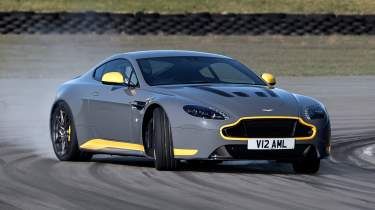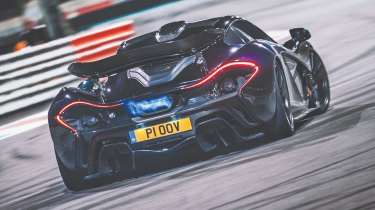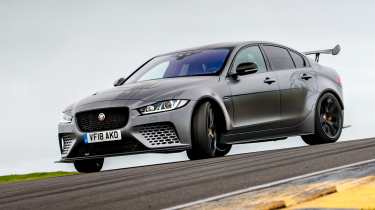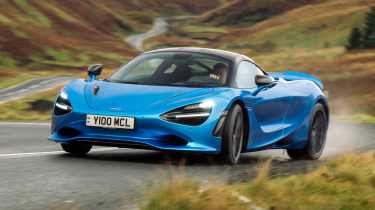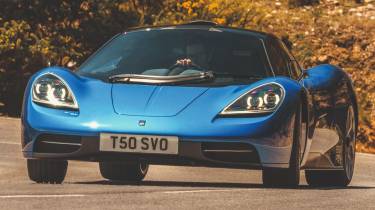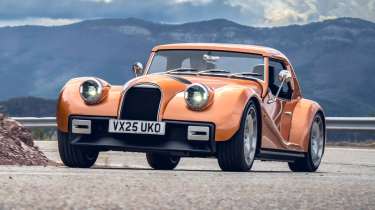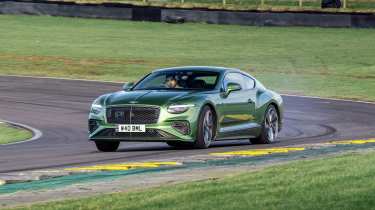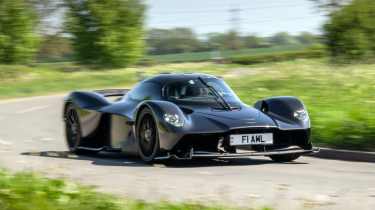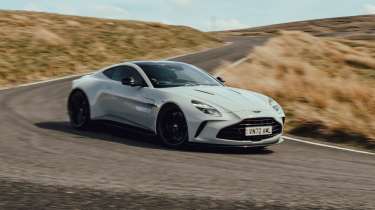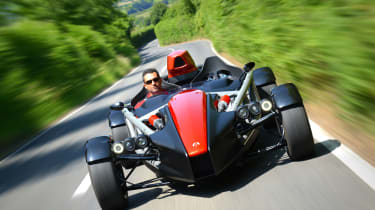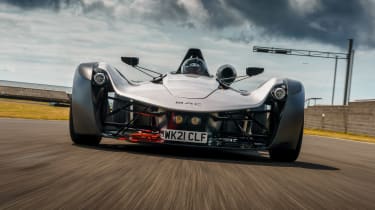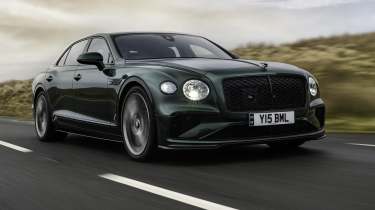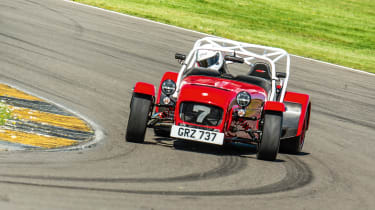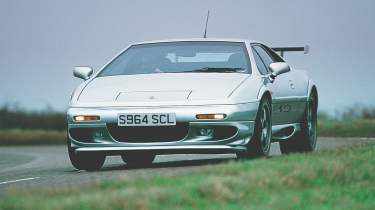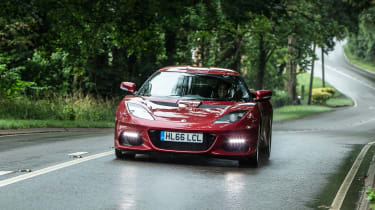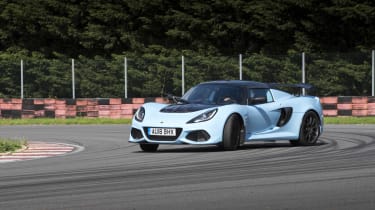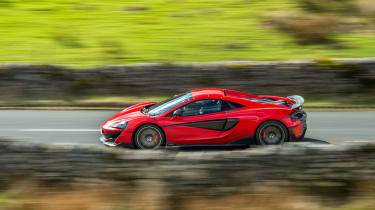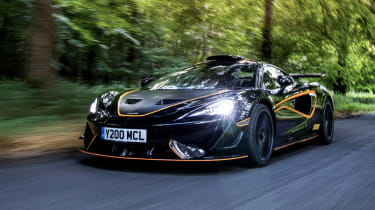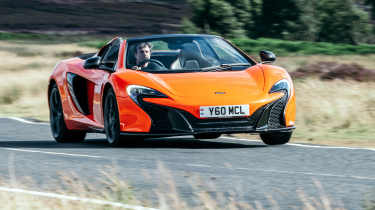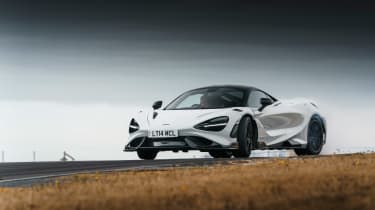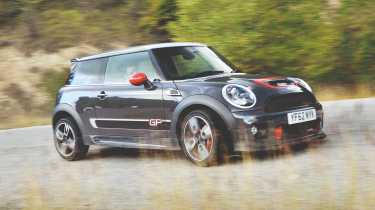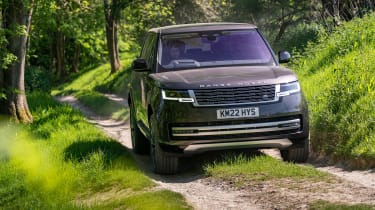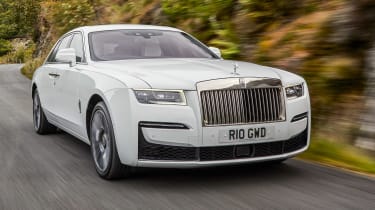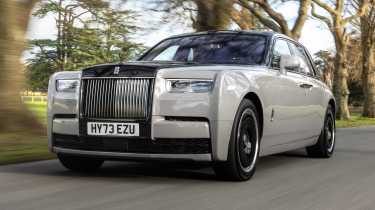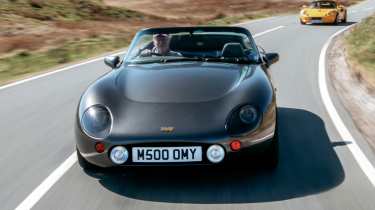Best British cars – the cars for Great Britain to be proud of
Britain still makes great cars, from luxury land yachts to scintillating sports cars to visceral supercars
While the British car industry isn’t known for consistently turning out back-to-back group test winners, it has produced some of the world’s most revered performance cars over the years; models that capture the innovation, engineering brilliance and charm it takes to deliver the Thrill of Driving in its purest form.
When viewed through an evo lens, narrowing the portfolio down, rather than struggling to make it up to ten, is the problem at hand. Read on for a rundown of the best British performance cars we’ve driven – ranks that the new Aston Martin Valhalla and McLaren W1, as well as the next wave of Lotus and Jaguar models, will surely be hoping to join.
McLaren F1
Prices from over £10million
Pros – Still the ultimate supercar, over three decades on
Cons – 90s headlights and brakes
We start with perhaps the ultimate British car – the McLaren F1. When Gordon Murray lays out a design brief, only the technology of the day will get in the way of him seeing through his vision. With the F1, that brief was to create the ultimate road-going supercar.
The engine – Paul Rosche’s glorious 618bhp S70/2 6.1-litre BMW M V12 – and six-speed manual transmission take it most of the way, but they really are the cherry on the cake that is the F1’s entire constitution. From the steering, to the handling, even to the view out and its compact dimensions. It’s all a product of Murray’s fanatical devotion to light weight and driver interaction, and his disdain for lazy engineering. The result is a car that, even over 30 years on from its introduction, sets standards when it comes to the Thrill of Driving.
‘Turn in, feel the slight push of the nose as the wheel goes a fraction lighter in your hands, a little lift of your right foot to transfer the weight and then back down for a quick bark of throttle to unstick the big 315-section rears. They’ll spin up quickly and the tail swings fast, but the steering knows what to do and you can let the perfect circle run through your hands into opposite lock as the car arcs round behind you. If you’ve got it right you’re now sliding an F1 and happier than Larry.’ – Henry Catchpole, evo contributor and former features editor, who tested the F1 against its spiritual successor, the Gordon Murray T.50.
Alternatives to the McLaren F1
Alternatives to the McLaren F1 can vary, depending on your motivation for having one. As a financial asset, a Rembrandt would do the trick. As a driving machine? Only the GMA T.50 has exceeded it over the last 30 years, and rightly, poetically so. Perhaps a Ferrari F50, Porsche Carrera GT or Pagani Zonda F are along the same carbon-tubbed, multi-cylindered, naturally aspirated, rear-drive, manual-transmissioned lines.
Lotus Elise S1
Prices from £16k
Pros – Light and lithe
Cons – Patchy fit and finish
It’s arguable that a number of principles that drove the conception of the McLaren F1 found a home in the Lotus Elise, which is why like the F1, it remains a high watermark today. Small, lightweight, tactile and compliant – as a tool to pick apart a dipping, undulating British country road, the Lotus Elise was a revelation.
A shoo-in, then, as one of the best British cars. But it’s not just the sum of its parts that makes the Lotus Elise so compelling; it’s the fascinating execution and journey to that end result. Yes, the F1’s place as the first all-carbon car makes it incredibly innovative – as well it should have been given it cost over £600,000 when new. But the Elise, for its price certainly, was arguably just as ingenious, debuting the bonded extruded aluminium structure that went on to define an entire generation of Lotus sports cars.
Aston Martin adopted a similar construction method that it continues to employ today, too. The lightest and most pure Elise is the Series 1, which weighed just 731kg and used a compact, lightweight Rover K-series engine, perfectly in-keeping with the car’s philosophy.
‘It will kick the tail wide if you’re keen, and do it tidily, but that’s not really its style. It’s the Elise’s deftness, its effortlessness across the ground that was unique and compelling back in 1996 and still is now. Back then, I got as many people into it as I could and it entertained and delighted them all, whether they drove or rode in it.’ – John Barker, evo co-founder and editor-at-large, who’s driven early Elises multiple times since the model’s launch in 1996.
Alternatives to the Lotus Elise S1
The Lotus Elise S1 treads a very careful line, combining the raw, unfettered interaction of a road-going racer like a Caterham, with just a hair more refinement, thanks to its closed body and road-biased, compliant suspension setup. Exact alternatives are few (okay, a Vauxhall VX220 is more or less exact) but we can say, Elise drivers would enjoy time behind the wheel of a Caterham, or a Mk3 Toyota MR2, or anything else that champions light weight, diminutive proportions and uncompromising driver interaction.
Caterham Seven evo25
Prices from £41,990 (Seven 420)
Pros – As raw as driving gets without rubbing your hands along the road
Cons – Far from an everyday driver’s car
British engineers love extremes as much as they love minimalism and as such, the Caterham Seven makes the Lotus Elise look like a Range Rover.
You are that much closer to the elements, that much closer in literal reach to the road passing beneath you and the noises you associate with motorised transport are that much louder; of the engine, the gearbox, the wind passing all around and the road surface grazing the tyres. The Caterham Seven is a masterclass in the essentials of the Thrill of Driving, and this is true from the basic three-cylinder 170 version, right up to the utterly manic 620R. The perfect performance car on which to base a special edition celebrating 25 years of evo, then.
It figures that the Caterham Seven evo25 should find a place on our list of the best British cars, because it’s our idea of the perfect Seven for use on both the road and on track. It combines a 210bhp Duratec motor, five-speed manual gearbox and 420 Cup suspension with comfort seats, the more practical ‘Trackday’ roll-cage and full weather equipment – heater and all. Caterham perfection.
‘I’d worried that the weighty steering would put a dampener on its on-limit playfulness but once I had a feel for the lines, it all became about the rear and managing mild, power-induced slip. It was brilliant fun, tactile and transparent, carrying speed where bigger, heavier cars were tentative, its braking points tens of yards after those same cars.’ – John Barker, evo co-founder and editor-at-large, who drove the Caterham Seven evo25 numerous times during our long-term test.
Alternatives to the Caterham Seven
The best alternative to a Caterham Seven is usually another Caterham Seven, albeit a different flavour. Perhaps a faster one, perhaps one with more track-focused suspension, or one with the wide-body. Further affield, an Ariel Atom comes close, as does a GBZ Zero or an original Lotus Elise.
TVR Sagaris
Prices from £80k
Pros – An intoxicatingly thrilling sports car, to drive and look at
Cons – A bit garish, usual TVR reliability caveats
TVR is on the other end of the spectrum to our other entries thus far, putting a particularly English spilt-pint, Marbella tan flavour of flamboyance at the top of its list of priorities over engineering excellence and outright precision. But over the years it’s turned out some glorious machinery, with the TVR Sagaris the pinnacle of the breed. It was the last TVR to be produced and benefitted from a number of detail changes that made it less quirky to live with and more functional.
While it probably still wasn’t enough to tempt buyers out of their BMWs and Porsches, it had much going for it. A low kerb weight of under 1100kg and a sublime straight-six that doled out over 400bhp endowed the Sagaris with a claimed 3.7sec 0-62mph time and a top speed of 185mph – thoroughly modern performance but achieved without modern niceties such as airbags, traction control or even ABS.
It could be a handful on the road and it didn’t respond well to being taken by the scruff of the neck, but if you were more measured with your inputs you could enjoy a whole lot more of what it had to offer – precise and instant turn-in, a balanced chassis and phenomenal pace.
‘There is considerable performance on offer, but only if the driver is first willing to invest the effort. That must make this deranged TVR one of the most absorbing performance motoring experiences of recent decades.’ – Dan Prosser, former evo road test editor, who drove the Sagaris in the UK.
Alternatives to the TVR Sagaris
The best alternative to the TVR Sagaris when it was new was of course, the TVR Tuscan 2. Nobody else made anything with the same raw, hard-hitting character for the price. A BMW Z4 M, with its S54 straight-six, is a pleasant approximation, albeit a more serious one with less of a sense of humour. Likewise a Porsche Cayman, which is a better car in every way but without the bombastic personality of the TVR.
Aston Martin V12 Vantage S
Prices from £70k
Aston Martin is perhaps the most beloved British brand. Indeed for all its years (most of them) of unprofitability, it’s survived by producing achingly desirable and beautifully designed GTs that even the hard-headed finance types of a certain giant American motoring monolith couldn’t ignore.
But in spite of how tumultuous the Ford era was, it arguably gave way to Aston’s very best era so far; that of the 5.9-litre V12 and the aforementioned VH aluminium platform. The car that perhaps best sums up that era and is probably an example of Aston at its best, is the V12 Vantage S. We love the V12 Vantage at evo. Such a big powerful engine in such a small car was always going to be hilarious, but not necessarily excellent dynamically. Thankfully, the V12 Vantage turned out to be almost precision-honed for the job of delivering driving thrills.
The V12 Vantage S then double-honed it, first puffing the voluminous V12 up to 565bhp, then adding a seven-speed manual transmission. Perfect? No – that ‘box is a bit notchy – but Astons, especially the V12 Vantage, endear in a way that isn’t contingent on objectivity.
‘Crowbarring 50 per cent more cylinders into a small car is childishly appealing to any enthusiast, but there was always the danger that Aston’s engineers could have created a caricaturish monster. They haven’t. It’s got character yet it’s refined; it’s got instant pace yet a depth that makes you want to live with it. Debonair and unafraid, it feels like a truly British Aston Martin.’ – Henry Catchpole, evo contributor and former features editor, who tested the V12 Vantage S on the road in the UK and on the launch.
Alternatives to the Aston Martin V12 Vantage S
For front-engined V12 thrills there is only one alternative: Ferrari, probably a 599 or an F12 for V12 Vantage S money. Both are bigger and not as agile as the Vantage. Look to the US and the C7 Corvette Z06 and SRT Viper offer similar silhouettes and performance levels.
McLaren P1
Prices from £1.5million
Pros – Enormously capable and fast yet exploitable and adjustable
Cons – Engine more industrial than lusty
Wrongly billed as an F1 successor when it arrived in 2012, the McLaren P1 was in a way lucky to escape the shadow of the Almighty. But then, to say it was luck would be to do the P1 a disservice, because it’s one of the most thrilling hypercars of any era, let alone its own. It was a first taste of McLaren Automotive at its best, with as much of a sense of humour as it has absolute technical majesty. A carbon monocell chassis, interlinked hydraulic suspension with variable ride height, Akebono carbon-carbon brakes and a hybridised powertrain with torque fill are just some of the highlights.
But translated out of Ron Dennis speak, it’s a car that can drop on its shocks and pop its enormous hydraulic DRS-capable wing ready for a monstrous lap, dropping the jaws of all in its presence in the process before even turning a wheel. It’s a car that has a combined 907bhp, that can eviscerate the rear tyres and dissolve like putty in the driver’s hands for spectacular big smokey drifts, having only just broken a record time the lap before.
It’s a technical tour de force that engages the driver in the most binary, interpretable way, presenting a banquet of awe and adrenaline at every rung of its performance envelope, from winding country roads to the very fastest Grand Prix circuits. The P1 is bleeding-edge motorsport science – itself a craft Britain masters – and quintessential hypercar theatre, triple distilled on four wheels wrapped in flow-formed carbon.
‘Driving a fully lit P1 has been likened to riding a firework. It’s intense and exhilarating and, if you attempt to deploy the IPAS battery boost or trigger the DRS system, a stern test of your ability to multi-task. Of course both are gimmicks, but I’d be lying if I said there isn’t endless fun to be had from feeling the surreal thump of battery power supplementing the on-boost V8. It’s genuinely like you’ve pressed the fast-forward button. Likewise, using the DRS button to wave bye-bye to whatever’s in your mirror is childishly amusing. Who says McLaren doesn’t have a sense of fun?’ – Richard Meaden, evo co-founder and editor-at-large, who drove the P1 on its launch at Yas Marina and numerous times since on track and on UK roads.
Alternatives to the McLaren P1
The P1 is a car as much defined by its rivals as it is its own towering technical and experiential offering. Arriving more or less at the same time as the Ferrari LaFerrari and the Porsche 918 Spyder, there was no escaping comparison. Which is fine, because they all brought something unique and special to the fight. On the outskirts were Pagani and Koenigsegg, at the time trotting out derivations of their Huayra and Agera hypercars.
Jaguar XE SV Project 8
Prices from £120,000
Pros – The ultimate road and track Jaguar
Cons – It’s pretty extreme for some tastes
In its standard form the Jaguar XE wouldn’t be getting close to a place on this list. That speaks volumes as to the extent of its transformation into the Project 8. This Jaguar SVO skunkworks machine is a genuinely serious performance saloon.
Project 8 is a machine that wears its heart on its sleeve – there’s no chance you could call the huge front and rear spoilers or blistered arches subtle – but they’re there for a purpose. And that’s to make the XE seriously fast. The body is almost exclusively made from carbonfibre or aluminium, the track’s wider and those 20-inch rims are wrapped in Cup 2s and hide 400mm front discs. Performance is courtesy of a 592bhp V8 which brings up the benchmark sprint in a blink-and-you’ll-miss-it 3.3sec – impressive for a 1.8-ton machine. But it’s not the Project 8’s straight line speed that’s its most impressive party trick as on the road it’s rapid, responsive and remarkably refined.
It feels light on its toes and the extremely precise steering allows you to perfectly position the big Jag. It’s balanced, has colossal grip thanks to its four-wheel drive and Cup 2 rubber (although it can be a little skittish in the wet) and the brakes wash off speed without complaint. It’s an amazingly rounded machine, and if you forgo the Track Pack that ditches the rear seats in favour of a roll cage, you could almost call it practical family transport.
‘Everything about it marries exaggeration with a tenacious accuracy. So often, shouty V8s and blistered, swollen bodywork are used to distract from a dynamic repertoire that’s big on brute force but actually rather blunt beneath the surface. The Project 8 balances shock and awe with an inherent sharpness that’s captivating.’ – Jethro Bovingdon, former evo contributor, who tested the Jaguar XE SV Project 8 against the BMW M3 CS and Alfa Romeo Giulia GTA.
Alternatives to the Jaguar XE SV Project 8
You wouldn’t imagine a left-hand-drive super saloon with the option of omitting the back seats would have many direct rivals but such is the car industry’s fetish for a niche, it does. That came in the form of the Alfa Romeo Giulia GTA, which could be had with as ludicrous an aero kit as the Jag and without the back seats, in Giulia GTAm form. An M3 CS is a super saloon on steroids too, albeit at a lower dose.
McLaren 750S
Pros – Hypercar pace and intensity, supercar price (and availability)
Cons – Engine not laden with character
While the P1 was a heady peak for McLaren, the 750S and indeed the 720S that preceded it, distilled limited-run million-pound thrills, minus the electrified element, into a production supercar anyone can order if they are sufficiently well-heeled.
It affirms that the supercars of today really are faster than the hypercars of yesterday. The 750S sets benchmarks for raw pace and technical acumen but also raw thrills and interactivity. The 720S that preceded it was McLaren shaking off any stylistic conservatism with a jaw-dropping design, and while the 750S is more of the same visually, it now has a shot of 765LT-style aggression in its DNA. In an age of hybridised and electric rivals, the 750S is the consummate supercar.
‘It goes without saying that the 750S is obscenely fast. Give it everything and the way it surges forward is eye-wideningly intense. It’s still driveable and intuitive, however, perhaps more so than something with about as much power as a ’90s F1 car behind your shoulder blades has a right to be.’ – James Taylor, evo deputy editor, who tested the 750S on track against the 992 Porsche 911 GT3 RS
Alternatives to the McLaren 750S
The 750S was McLaren’s obvious riposte to the hybrid-powered Ferrari 296 GTB. If you were after a more expressive powertrain but still with an incredibly rewarding and intense driving experience, a Lamborghini Huracán Evo RWD or STO would fit the bill too.
Aston Martin Vanquish
Prices from £350,000
Pros – Enormously fast yet an exploitable, usable, beautiful GT
Cons – Expensive, heavy
Aston Martin’s post-VH era of sports cars and GTs has shown so much promise but some of these models have been flawed in key areas, from ergonomics to dynamics and sometimes even in terms of style. Not everyone got on with the DBS of 2018, as an alternative to the Ferrari 812. The new Vanquish that takes its place however, a development of that car, is a total debug. More than that, the Vanquish is now on a level of form that puts it potentially beyond that of the 12 Cilindri, it’s main rival from Ferrari.
Nevermind that it’s arguably the prettiest Aston since the original V12 Vantage of 2009, it’s also one of the most transparent and engaging to drive, in spite of its voluminous 824bhp potency also making it most powerful front-engined GT it’s ever made, One-77 included. When we drove the run-out DBS 770 Ultimate, we really hoped that Aston would pick up where that exceptional super GT left off. The Vanquish absolutely does, and then some. Absolute power doesn’t corrupt absolutely if harnessed with the kind of capability the Vanquish exhibits.
‘The Vanquish ticks an awful lot of boxes: It looks wonderful, sounds amazing and offers spectacular performance. It’s sharp, tactile and engaging when you want it to be, satisfying the super-GT part of the brief, and nails the pure GT part too, with a continent-crossing combination of supple low-speed ride, firm but comfortable seats, superb wind noise refinement and an outstanding sound system.’ – John Barker, evo co-founder and editor-at-large who tested the Vanquish on the launch.
Alternatives to the Aston Martin Vanquish
The obvious rival to the Vanquish is the Ferrari 12 Cilindri, though its predecessor, the 812 Superfast, is the more intense front-engined supercar, if that’s what you’re looking for. Likewise, for folding money less, a used DBS 770 Ultimate is a mighty thing.
GMA T.50
Prices from £2.8million
Pros – Driving perfection, as it says on the tin
Cons – All are sold and no doubt doubled in value
We now come full circle with Gordon Murray’s spiritual successor to the McLaren F1: the GMA T.50. Everything he couldn’t do in the early 1990s, he wanted to do here. Everything he found in hindsight to be wrong with the F1 – even if he was the only one who saw it that way – he wanted to do right this time. In some ways, the T.50 has been painstakingly refined – the result of a detailed audit of the F1. In others, though, it’s a totally different animal.
That Cosworth V12, which famously rounds the tachometer all the way to 12,100rpm, kicking out 656bhp along the way, has a character at full chat closer in kin to McLaren’s 1991 F1 car than its 1993 road car. Its design has more of a ‘60s-inspired sensuality – minus perhaps the fan at the rear – than the F1’s quite contemporary, modernist look. But the core tenets of the F1 are built upon and are enshrined in GMA’s motto: Driving Perfection.
The T.50, with its deftly-honed passive suspension, only partially-assisted steering, obsessively-crafted gear shift, sub-1000kg kerb weight and cacophonous V12 is every bit the new standard bearer to take over from the F1.
‘I’ve never known acceleration so addictive. It doesn’t have that beautiful, rich induction sound of the McLaren but its frenzied fierceness, like VTEC on fast-forward, makes the hairs stand up on the back of your neck every time you crack the throttle. But the chassis is fun and lets you truly use the engine rather than just experience it. There is a predictability and playfulness that combines with the razor-sharp response of the engine to let you balance the car with a sort of wide-eyed ease.’ – Henry Catchpole, evo contributor and former features editor, who tested the T.50 against its spiritual predecessor, the McLaren F1.
Alternatives to the GMA T.50
Gordon Murray’s teachings from the good book analogue have gained traction in recent years. Boutique hypercar proprietors like Pagani, Koenigsegg and others have returned to offering elegant forms enveloping manual transmissions, with the Utopia and CC850 just two examples. A 911 reimagined by Singer DLS has similarly obsessive, jewel-like engineering and a resolutely analogue driving experience, too.
Morgan Supersport
Prices from £102,000
Pros – The most usable and capable Morgan yet
Cons – Still has some dynamic and usability compromises next to a Porsche
Delicate, tricky, is the task of modernising Morgan, for if you go too far, you risk bonfiring the whole thing. So important is a Morgan’s antiquity to its character. Happily, the folks in charge in Malvern at the moment absolutely get it. So in the new Morgan Supersport, we have a Morgan that maintains the classic look, albeit with a veneer of restomod-esque modernity, quality and attention to detail.
It looks great but what makes the Supersport one of the best British cars of the moment, is that it pulls off the same trick in terms of how it drives. The new CXV platform is stiffer, the steering is more precise, the suspension has been overhauled and they’ve fitted proper wheels and tyres. Fitted with Nitron dampers and the optional Drexler limited-slip diff, this is a proper, playful sports car, contemporary in its willingness and ability. It’s easier to live with too, with more space inside, improved quality and a choice selection of toys – who saw bluetooth phone connectivity coming for Morgan? In the Supersport the charm is still there, with a new dimension of modernised style, dynamics and livability. A Morgan you can have as a second car, rather than a fifth car.
‘The Supersport is a car with a far wider bandwidth than a typical low-volume sports car. Its aesthetics move the Morgan template forward without diluting its appeal, it possesses more day-to-day usability than ever, and its dynamics are impressive. It’s a car that could appeal not only to die-hard Morgan fans but to a wider group of customers who might not previously have considered a car from Malvern. It deserves their attention.’ – James Taylor, evo deputy editor, who drove the Morgan Supersport on the launch.
Alternatives to the Morgan Supersport
The Morgan Supersport is a six-cylinder-engined two-seater sports car, so there are a few alternatives, that mostly come from Porsche. A GTS 4.0 Cayman or Boxster with a manual would suit nicely, as would a 911 Carrera T. The V6 Lotus Emira should be a good fit too. Will nothing but a B58 do? A Z4 Handschalter could fit the bill. Notice, all are available with manual gearboxes, where the Morgan sadly is not.
Bentley Continental GT Speed
Prices from £240k
Pros – Immaculately engineered, blisteringly quick and capable
Cons – Almost unacceptably heavy, not a touchy-feely driver’s car
Of all the marques in this boutique luxury space, Bentley is perhaps in the best position given the times we’re in. For in 2025 there’s not a Bentley on sale that can’t be had with quite a sturdily sized battery and strong emissions-free electric range. Happily, partial electrification comes with a significant bump in power and performance, to over 771bhp.
That does mean extra weight – the Continental GT Speed is now close to 2.5tons – but clever air suspension tech, active anti-roll control, rear-steering and a proper limited-slip diff afford this stately bus otherworldly control and agility. An Aston or a Maserati might be lighter and more dynamic but we’d challenge anyone to prove the Continental GT Speed wouldn’t fit into their everyday lives with more purpose and usability.
‘It still has the same continent-crossing comfort, sense of presence, and an enjoyable soundtrack: the V8 is a truly characterful engine and the hybrid powertrain is integrated in such a way as to expand the car’s repertoire rather than restrict it. With more exposure to the GT at higher speeds, perhaps the increased weight will make itself known – this is a 2.5-tonne car after all. But on this first impression, hybrid power suits the Continental.’ – James Taylor, evo deputy editor, who drove the Continental GT Speed on the launch and on track in the UK.
Alternatives to the Bentley Continental GT
The Continental GT operates in one of few high-performance markets that remains hotly contested. Don’t want a hybrid? Look to the Aston Martin DB12 and Maserati GranTurismo. If electric augmentation is highly appealing but you want to spend a chunk less, the new Mercedes-AMG GT 63 S E Performance should be on your shortlist.
evo’s other favourite Brits
The list above is by no means a comprehensive run-down of our favourite British cars, and it’d be doing you and the cars themselves a disservice not to mention some of our other highlights, from the most intense supercars, to the most superb luxury models.
Aston Martin Valkyrie
It’s been a while since you could go out and buy a top-flight Le Mans car for the road – the last time was probably around the era of the Porsche 911 GT1 and Mercedes CLK GTR. Yet that’s exactly what the Adrian Newey-designed Valkyrie is, as anyone who watched 2025’s 24-hour race can attest. The road car is hot, extremely noisy, and occasionally pernickety, but also an intense experience and a remarkable achievement, from its aero-first bodywork to the staggering 11,000rpm Cosworth V12 – and that despite those things it can still, mostly, be driven on the street; evo’s James Taylor even drove one from the UK to Le Mans.
Aston Martin Vantage
It’s taken a couple of goes, but Aston Martin has finally nailed it with the latest Vantage, the best iteration since 2005’s deeply appealing V8 Vantage. The latest car is hard to fault in the styling department, just as a good Aston should be, and with 656bhp it certainly doesn’t fall short on performance, with multi-stage traction control to keep things in check. But best of all, it has wonderful balance which allows you to exploit all that power, with enough communication to reassure you throughout the process. For that, we can forgive the occasionally brittle ride and slightly confusing touchscreen inside.
Ariel Atom
It’s hard to believe the original Ariel Atom is now a quarter of a century old. Like all the best cars (and a lot of the other Brits on this list), it’s essentially timeless – the qualities that made it great back then still apply today. The earliest models could be a little bit of a handful in some conditions, truth be told, but Ariel worked hard to refine it over the years, while the basic recipe has remained unchanged over the decades. It’s still a work of engineering art to behold and deeply exciting to drive, without, as so many others have done, simply copying the Caterham formula.
Ariel Atom 4
Here at the other end of two and a half decades, is the Atom 4. Around since 2018, it now uses turbocharged four-cylinder Honda power, making 320bhp in the 4 and a full 400bhp in the 4R, the latter adorned with large front and rear wings to produce 110kg of downforce at 70mph. Massive performance is a given, though if it all gets too much, you do get three stages of boost, so you can ease your way up from about 200bhp. It only weighs 595kg too, and you feel that in the way the Atom 4 moves – blistering in a straight line, and not much slower in corners.
BAC Mono
Briggs Automotive Company, BAC, launched the Mono in 2011, and to this day there’s been nothing quite like it – other than BAC’s own updated Monos and 2019’s more extreme Mono R. Speak to the Briggs brothers and their aim was clear: a road car completely uncompromised by normal road-car constraints. So you only get one seat, since a passenger is only dead weight, a central driving position, and a mechanical layout more racer than road car. It really is built for high speeds, being a bit clunky and industrial at a crawl, but extend it, and few cars are more exciting.
Bentley Flying Spur
Mechanically similar, we reckon the Flying Spur is just that bit cooler than Bentley’s own Continental GT. A proper Bentley really needs four doors, doesn’t it? The styling is grand and imposing and the cabin truly beautifully appointed if, ironically in 2025, a little too festooned with buttons. Now driven by a V8 hybrid rather than the old W12, performance is truly effortless, and the drivetrain strikes the ideal balance between solitude and burbling V8 noises. Despite weighing 2.6 tonnes, it’s also great to drive, always managing to keep its mass in check.
Bentley Mulsanne
The Mulsanne disappeared from Bentley’s lineup in 2020, but we’ve still not forgotten it. Even more so than the Flying Spur it defined how a Bentley should feel – namely, incredibly luxurious and undemanding to drive, but still capable of surprising the driver with its abilities. The last Bentley to be fitted with the old ‘six and three-quarter litre’ V8 (making 505bhp as standard, 530bhp in Speed form, with 752lb ft and 811lb ft respectively), it moves so effortlessly that the tachometer needle rarely strays above about 2000rpm. Yet, as we found, you can also have a conversation at normal indoor volumes doing nearly 180mph on the autobahn…
Caterham 420 Cup
‘Few mechanical devices on four wheels are as entertaining or thrilling’ is how we summed up the Caterham 420 Cup in our full, five-star review. We could probably just leave it there – after all, Caterhams have always been about as good as it gets for automotive thrills, but the impressive thing is how the brand occasionally seems to one-up itself with a new model. The track-spec 420 Cup is just such a car, with a sequential gearbox, Bilstein dampers, and a roll cage thrown into the mix. What a car.
Caterham R500
By most standards Caterhams are already ‘super light’, but given Caterham applied the Superlight term to its R500 in 2008, you know it really wasn’t joking. With a 263bhp Duratec engine in place of the previous R500’s Rover K-series, a lightweight chassis and thinner body panels, Caterham got weight down to only 506kg, giving 528bhp per ton – more than a Bugatti Veyron. You got the same compromises as all Caterhams, but amplified thrills
Jaguar F-type SVR
The Jaguar F-type was not a car that felt like it needed a more extreme variant; after all, the F-type R finished an impressive second in eCoty 2014, to a Ferrari 458 Speciale. But in 2017 we got the F-type SVR, its supercharged V8 boosted by 25bhp and 15lb ft (to 567 and 516), a titanium and inconel exhaust, and a few suspension tweaks. Sure enough, it managed to be both incisive and still comfortable-riding, and of course, fairly brisk – 0-60mph took only 3.5sec. Overkill, perhaps – the noise was a little much – but a real British muscle car.
Land Rover Defender Octa
On the basis it’s getting harder to explore a car’s performance on the road in 2025, here’s a car that doesn’t even bother with the roads. Another JLR SVO project, Octa is to the Defender as the Project 7 and 8 were to their Jaguar counterparts, cleverly honed to excel in its chosen environment. The BMW-sourced 4.4-litre twin-turbo V8 makes 626bhp, which feels interesting indeed from the Defender’s high perch, but the suspension with its hydraulically-linked active dampers is more than up to whatever surface you fancy. It’s pretty hilarious, and very impressive indeed.
Lotus Emira
Time will tell if the Emira really is the final combustion-engined Lotus (given the brand’s EV strategy isn’t exactly roaring along) but if it is, it’s not a bad one to go out on. Great to look at and typically good to drive, the Emira feels like a proper Lotus but gets a lot closer to the likes of Porsche for quality than its predecessors ever did. The downside of this push upwards is expense, but you do now get a choice of the old Toyota V6 with a manual and an AMG-sourced turbo four with a DCT, for surprisingly different driving experiences. Some refinement is still needed, but we’re glad the Emira exists.
Lotus Esprit Sport 350
If you think the Nissan GT-R hung around for a while (15 years), or even the Lotus Elise (25 years), then the Esprit topped them both, its 1976 to 2004 span covering 28 years. Impressively, Lotus kept it relevant the entire time, from its wedgy 70s beginnings to the true supercar it became with the punchy Sport 300 and then the ultimate Esprit, the 3.5-litre, 349bhp twin-turbo V8-powered Sport 350. Already a master of mid-engined handling, the 350 looked and felt more aggressive, suiting a burgeoning cohort of people taking their cars on track – though Lotus built only 50 examples of its most extreme Esprit.
Lotus Evora
Nothing less than 2009’s evo Car of the year winner, the Evora was, and still is despite ending production in 2021, a great Lotus and a great driver’s car. That early eCoty winner seems surprisingly modest by today’s standards, its Toyota-sourced 3.5-litre V6 making ‘only’ 276bhp, one of the least powerful victors ever. But we all know better by now that power isn’t everything, especially in a Lotus, and while the Evora did gain a supercharger and bigger numbers as the years went on, the beautifully detailed steering, expansive and cab-forward view through the windscreen, and deft, well-controlled ride remained a constant. It still looks good too, we reckon – less exotic but more individualistic than the Emira that replaced it.
Lotus Exige
The Exige is another Lotus that evolved over the years, but we’re going for the original ‘S1’ version here, for its true road-racer feel. Barely heavier than the Elise it was so obviously based on, the 780kg Exige featured wings and splitters capable of generating 100kg of downforce at 100mph, and a roof to really pin you in with the feral noises produced by the two Rover K-series powerplants – one with 177bhp, the other 192bhp. The Exige added racer-style brutality to the all-encompassing Elise experience.
McLaren 600LT
And now begins a string of McLarens to add to the F1, P1, and 750S further up. We make no apologies: McLaren consistently turns out some of the world’s best supercars, and the 600LT is a five-star favourite – ‘poise, power, and purity – McLaren at its best’ is the succinct subheading for our 600LT review. Based on the 570S, the flame-spitting 600LT is to that car as the Exige is to the Elise, honed in every dynamic area for a more intense experience, and McLaren managed to shed 84kg from the 570’s weight too – 21kg from the seats alone, thanks to the Senna-style buckets.
McLaren 620R
You might have forgotten this one in McLaren’s ever-evolving lineup, but we haven’t. The 620R was essentially a road-going version of the brand’s 570S GT4 racer, and McLaren made only 225 of them – for about quarter of a million quid a pop. A lot beside a 570S (or a lightly-used 720S) but it expertly blurred the line between racing and road, being great fun (and obviously very quick) on track, but still fun and exciting on the public highway – helped by usual McLaren high points like richly textured steering feel and the tactile click of the DCT’s paddle shifts.
McLaren 650S
The earliest examples of the 650S are now more than a decade old, but you wouldn’t know it from the way it drives. The 650S felt like McLaren getting into its stride, with a little more (if not yet all) of the character that its 12C predecessor arguably lacked, and dynamic refinements that set the company on the path followed by all its subsequent supercars. Of course performance took a step upwards too, and while subsequent McLarens have been faster still, you’d be hard-pressed to say the 650S was ever lacking in its straight line speed or cornering abilities…
McLaren 675LT
The 675LT narrowly missed out on an eCoty win when it finished second to the original Cayman GT4 in 2015. It remains one of our favourite McLarens, with a familiar formula. The “LT” for Long Tail moniker has always seemed a little optimistic, given only millimetres separate these enhanced variants from the cars they’re based on (in this case, the 650S above), but philosophically the gap is much greater – the 675LT showed that McLaren could do raw fun and emotion as well as just staggering speed. Plenty of that too, obviously – in fact, we reckoned it’d give the McLaren P1 a hard time, which maybe wasn’t surprising when the P1 had donated so many parts.
McLaren 765LT
Yup, another LT, this one based on the 720S, and another that came within a whisker of an eCoty win, this time in 2020 (when the BMW M2 CS was the victor). The 765LT was a little longer-tailed than most too, with a striking aero kit that gave the curvy 720S shape a bit of grit. The formula stayed the same though: a little faster (thanks to 755bhp) and more intense absolutely everywhere (especially when it rained during eCoty), but losing none of the feel and sense of occasion we love about McLarens; its steering remains a high point, up there with the best modern cars full stop.
Mini John Cooper Works GP
Now becoming as much a collector car as an enthusiast’s one, the original “Mini Works GP” is one of our favourite noughties hot hatches. The regular Mini was already great – compact, tactile, adjustable, but feeling like a quality product. Binning the back seats for a big strut brace, tweaking the supercharged 1.6 for 215bhp, and swapping out wheels and suspension parts for lightweight alternatives gave it the feel of a front-drive BMW M-car, and it doesn’t look as OTT as it used to. It was fluid and fun, and predated the similar ethos of the Megane R26.R by a couple of years.
Mini John Cooper Works GP2
You won’t find the third-generation Works GP here, because it was a bit of a nail frankly, all torque steer, rigid ride and no finesse. But the second-generation R56 Works GP, based on the R56 Mini, showed the GP recipe could stand a little extra spice without overdoing things. Now turbocharged it made the same 215bhp as the previous car, but was a little stiffer and more aggressive, and with sticky Kumho rubber it was a riot in the corners while retaining just enough civility for regular use (though still no back seats). Unlike its successor, you still got a snappy manual gearshift to play with, too.
Range Rover
A Range Rover might not seem especially evo, and it’s true that this two-tonne-plus behemoth designed to insulate you from the road rather than connect you to it is not what you’d call a thrilling driving machine. But it’s what you might call the perfect counterpoint car, a vehicle so far removed from the Caterhams and hot hatches that it perfectly complements their ownership. That it can easily tow your average trackday toy also makes it rather useful, and don’t think that just because it’s not exciting, it’s not good to drive – far from it. Piloting a Rangie is always an experience, they’re pretty powerful these days, and it’s a lot classier than most house-sized SUVs.
Range Rover Sport SV
The last couple of generations of Range Rover Sport have been granted a special performance version, and the Sport SV is the best yet. Where its SVR predecessor was fun but disquietingly obnoxious, the SV is a welcome few steps closer to trad Range Rover class, but still packed with deeply impressive engineering that somehow turns it into a genuine driver’s car. It’s no exaggeration to say that having driven it on track, the SV doesn’t feel out of its depth; it’ll pull 1.2g on a Michelin Pilot 5 S, for Pete’s sake. The 625bhp BMW-supplied V8 is mighty too, as are the carbon-ceramic brakes, yet it turns back into a proper luxury car on the road.
Rolls-Royce Ghost
More so even than the Range Rover further up, the Ghost strays quite far away from evo’s usual idea of a driver’s car. Yet again, that doesn’t mean we don’t like driving it, which is a sign of how well-honed a modern Rolls-Royce has become. Its ability to dismiss the surface beneath is as impressive in its own way as a 911 GT3’s ability to shrug off the Foxhole at the Nurburgring, while the 6.7-litre twin-turbo V12 defines “effortless”. That said, the brand’s recent move into EVs with the Spectre suggests that, of all cars, its successor could be even better with electric power.
Rolls-Royce Phantom
We’re opting for the Phantom VII here, 2003’s magnificent, opulent and imposing luxury saloon that has defined the brand’s direction for the 21st century. It showed that, like Mini, an iconic British brand was in good hands at BMW, and that finally furnished with the budget they lacked in preceding decades, the British engineers behind it could still turn out a world-beating product. Obviously, the Phantom was quite remarkable to drive – a capable handler, but really all about its ride and isolation. Unsurprisingly, never an eCoty entrant, but that doesn’t make it any less significant.
TVR Griffith
Obviously we’re talking about the brilliant 1990 to 2002 original here rather than the embarrassing on-again off-again project mooted way back in 2017. The original is an all-time classic British sports car: great to look at, powered by an amusingly vocal Rover V8, wickedly fast thanks to weighing barely more than a Mazda MX-5 (dry, at least), and actually, bloody brilliant to drive. Yes, a Griff can be a bit of a workout, but the rewards are always there. Decades of knowledge can even make them pretty reliable these days - it’s no surprise the Griffith remains in high demand on the used market. We recently included the Griff on our 1990s evo “eras” test; it right up there with the Porsche 996, Subaru Impreza, and Lotus Elise as one of the era’s most notable driver’s cars.
TVR Tuscan
The Tuscan carried TVR into the 2000s, and what a car it was. The styling is still a stand-out today – surely one of the all-time great profiles – but motivated by TVR’s in-house “Speed Six” inline six-cylinder (upwards of 360bhp from four litres) it’s a riot to drive, scaring contemporary supercars in a straight line, making a BMW M-car straight six sound like a hairdryer, and changing in character throughout the rev range. Yet the Tuscan also handled. Accept there’s nothing to save you if you get it wrong, and you’ll find sharp steering, sweet balance and plenty of adjustability – better in later cars, as early ones were a little soft.

